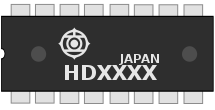| Hitachi | |||||||||
| | |||||||||
| Type | Public | ||||||||
| Founded | 1910 Hitachi, Ibaraki, Japan | ||||||||
| Founder | Namihei Odaira | ||||||||
| Headquarters | Chiyoda, Tokyo, Japan | ||||||||
| Website | http://www.hitachi.com | ||||||||
| |||||||||
Hitachi, Ltd. is a Japanese multinational conglomerate company.
Contents
History
Hitachi was founded in 1910 by electrical engineer Namihei Odaira in Ibaraki Prefecture, northeast of Tokyo. Hitachi started already in 1965 the development of Integrated Circuits (ICs), based on technology from RCA in the USA.
The first products of the HD100 Series were designed in ECL (Emitter-coupled Logic) technology, a high-speed bipolar transistor logic family using a 15 um manufacturing process and used in October 1966 with Sharp's CS-31A, the World’s first electronic calculator incorporating ICs.
Hitachi followed soon with the HD700 Series, a family of SSI (Small Scale Integration) ICs in PMOS (p-channel Metal-oxide Semiconductor) technology and consisting of simple inverters, logic gates, flip flops and 4-bit to 16-bit shift registers, packaged in 10-pin and 12-pin metal can housings (TO-100 and TO-101, respectively) and operated with a single 24V supply. These kinds of chips, commonly referred as JMOS devices for Japanese MOS, were manufactured around 1966 to 1971 not only by Hitachi, but with similar or identical functionality, from companies like Mitsubishi, NEC and Toshiba, too and provided similar functionality to the DTL and TTL Logic Families introduced in the Western world.
Microprocessors
- Hitachi 6309 (Motorola 6809)
Microcontrollers
Calculators Chipsets
- HD3203 (1971) • Program Memory Chip (24 pin Ceramic)
- HD3205 (1971) • Program Memory Chip (24 pin Ceramic)
- HD3210 (1971) • Input Chip (24 pin Ceramic)
- HD3211 (1971) • Timing and Program Sequencer (24 pin Ceramic or Plastic)
- HD3212 (1971) • Data Chip (ALU) (24 pin Ceramic)
- HD3214 (1971) • Data Memory Chip, 3x 64-bit Shift Registers (16 pin Ceramic)
- HD3215 (1971) • 12-digit (24 pin Ceramic or Plastic)
- HD3216 (1971) • 12-digit (24 pin Ceramic or Plastic)
- HD3217 (1971) • 12-digit (16 pin Ceramic or Plastic)
- HD3218 (1971) • 12-digit, Memory (24 pin Ceramic or Plastic)
- HD3219 (1971) • Display Chip (24 pin Ceramic or Plastic)
- HD3223 (1972) • Single-chip (Multi-chip Package)
- HD3226 (1971) • (16 pin Plastic, MSI)
- HD3227 (1971) • 2 Flip-Flops (16 pin Plastic, MSI)
- HD3233 (1971) • 6 Inverters (16 pin Plastic, MSI)
- HD3235 (1972) • LSI, 10 um PMOS (28 pin Plastic)
- HD3236 (1972) • LSI (28 pin Plastic)
- HD3237 (1972) • LSI (28 pin Plastic)
- HD3633 (1974) • 8 digits, Single-chip
- HD36290 (1974) • 8 digits, Single-chip
LSI/MOS Packaging Timeline
- Jan. 1971 - 42-pin QIP White Ceramic, Round Metal Lid (HD3201 Series)
- Apr. 1971 - 28-pin DIP White Ceramic, Round Metal Lid
- Apr. 1971 - 16-pin DIP White Ceramic, Rectangular Metal Lid
- Sep. 1971 - 28-pin DIP White Ceramic Multichip, Rectangular Metal Lid
- Sep. 1971 - 28-pin DIP Plastic
- Jan. 1972 - 24-pin DIP Plastic
| This article is still a stub and needs your attention. You can help improve this article by editing this page and adding the missing information. |
| company type | public + |
| founded | 1910 + |
| founded location | Hitachi, Ibaraki, Japan + |
| founder | Namihei Odaira + |
| full page name | hitachi + |
| headquarters | Chiyoda, Tokyo, Japan + |
| instance of | semiconductor company + |
| name | Hitachi + |
| website | http://www.hitachi.com + |
| wikidata id | Q53238 + |

